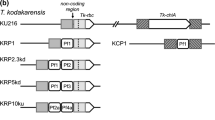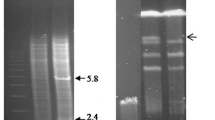Abstract
Plasmid pULB113 (RP4::Mini-Mu) promoted homologous gene transfer inAeromonas hydrophila; transfer of chromosomal markers occurred at frequencies of between 10−3 and 10−4 per donor cell regardless of the marker selected; this indicated chromosome transfer from multiple origins. With a variety of amino acid biosynthetic markers, a single circular map of this bacterium was constructed.
Similar content being viewed by others
Literature Cited
Adams D, Atkinson HM, Woods WH (1983) The differing effect of proteases on the adhesins ofAeromonas hydrophila. FEMS Microbiol Lett 20:197–200
Burke V Robinson J, Gracey M, Peterson D, Meyer N, Haley V (1984) Isolation ofAeromonas spp. from an unchlorinated domestic water supply. J Appl Environ Microbiol 48:367–370
Burke V, Robinson J, Gracey M, Peterson D, Partridge K (1984) Isolation ofAeromonas hydrophila from a metropolitan water supply: seasonal correlation with clinical isolates. J Appl Environ Microbiol 48:361–366
Chakraborty T, Montenegro MA, Sanyal SC, Helmuth R, Bulling E, Timmis KN (1984) Cloning of enterotoxin gene fromAeromonas hydrophila provides conclusive evidence of production of a cytotoxic enterotoxin. Infect Immun 46:435–441
Cumberbatch N, Gurwith MJ, Langston C, Sack RB, Brunton JL (1979) Cytotoxic enterotoxin produced byAeromonas hydrophila: relationship of toxigenic isolates to diarrhoeal disease. Infect Immun 23:829–837
Dixon R, Cannon F, Kondorosi A (1976) Construction of a P plasmid carrying nitrogen fixation genes fromKlebsiella pneumoniae. Nature 260:268–271
Gracey M, Burke V, Robinson J (1982)Aeromonas-associated gastroenteritis. Lancet 2:1304–1306
Guirard BM, Snell EE (1981) Biochemical factors in growth. In: Gerhardt P (ed) Manual of methods for general bacteriology. Washington. American Society for Microbiology, pp 79–111
Hubbard GB (1981)Aeromonas hydrophila infection inExnopus laevis. Lab Anim Sci 31:297–300
Huizinga WH, Esch GW, Mazen TC (1979) Histopathology of red sore disease (Aeromonas hydrophila) in naturally and experimentally infected large mouth bass (Micropterus salmonides). J Fish Dis 2:263–277
Kaper JB, Lockman H, Colwell RR, Joseph SW (1981)Aeromonas hydrophila: ecology and toxigenicity of isolates from an estuary. J Appl Bacteriol 50:359–377
Kirov SM, Wellock R, Goldsmid JM (1984)Aeromonas species as enteric pathogens. Aust Microbiol 5:210–214
Lejeune P, Mergeay M, Van Gijsegem F, Faelen M, Gerits J, Toussaint A (1983) Chromosome transfer and R-prime formation mediated by plasmid pULB113 (RP4::Mini-Mu) inAlcaligenes eutrophus CH34 andPseudomonas fluorescens 6.2. J Bacteriol 155:1015–1026
Ljungh A, Wadström T (1983) Toxins ofVibrio parahaemolyticus andAeromonas hydrophila. J Toxicol Toxin Rev 1:257–307
Pemberton JM, Bowen ARS (1981) High-frequency chromosome transfer inRhodopseudomonas sphaeroides promoted by broad-host-range plasmid RP1 carrying mercury transporson Tn501. J Bacteriol 147:110–117
Pitrangsi C, Echeverria P, Whitmire R, Tirapat C, Formal S, Dammin GJ, Tingtalapong M (1982) Enteropathogenicity ofAeromonas hydrophila andPlesiomonas shigelloides: prevalence among individuals with and without diarrhoea in Thailand. Infect Immun 35:666–673
Richardson CJL, Robinson J, Wagener LB, Burke V (1982) In vitro susceptibility ofAeromonas spp. to antimicrobial agents. J Antimicrob Chemother 9:267–274
Schoonejans E, Toussaint A (1983) Utilization of plasmid pULB113 (RP4::Mini-Mu) to construct a linkage map ofErwinia carotovora subsp.chrysanthemi. J Bacteriol 154:1489–1492
Turnbull PCB, Lee JV, Miliotis MD, Van de Walle S, Koornhof HJ, Jeffery L, Bryant TN (1984) Enterotoxin production in relation to taxonomic grouping and source of isolation ofAeromonas species. J Clin Microbiol 19:175–180
Van Gijsegem F, Toussaint A (1982) Chromosome transfer and R-prime formation by an RP4::Mini-Mu derivative inEscherichia coli, Salmonella typhimurium, Klebsiella pneumoniae andProteus mirabilis. Plasmid 7:30–44
Van Gijsegem F, Toussaint A (1983) In vivo cloning ofErwinia carotovora genes involved in the catabolism of hexauronates. J Bacteriol 154:1227–1235
Vogel HJ, Bonner DM (1956) Acetylornithinase ofEscherichia coli: partial purification and some properties. J Biol Chem 218:97–106
Author information
Authors and Affiliations
Rights and permissions
About this article
Cite this article
Gobius, K.S., Pemberton, J.M. Use of plasmid pULB113 (RP4::Mini-Mu) to construct a genomic map ofAeromonas hydrophila . Current Microbiology 13, 111–115 (1986). https://doi.org/10.1007/BF01568292
Issue Date:
DOI: https://doi.org/10.1007/BF01568292




